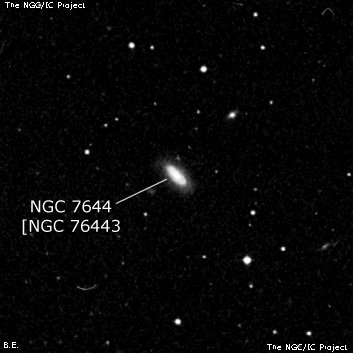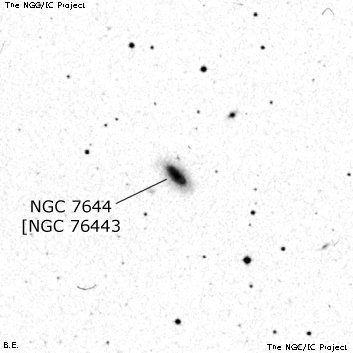NGC/IC Project Restoration Effort
(This is a very very beta version)
NGC7644


Basic Information
Location and Magnitude
Right Ascension: 23:22:50.4
Declination: +11:59:19
Constellation: PEG
Visual Magnitude: 13.2
Historic Information
Discoverer: Swift L.
Year of discovery: 1886
Discovery aperture: 16.0
Observational
Summary description: vF, pS, lE
Sub-type: S?
Corwin's Notes
=====
NGC 7644. There is nothing at Swift's nominal position. He found the object
on 29 September 1886, calling it only, "vF, pS, lE." I wrote previously that
"The faint galaxy two arcmin following is too faint and too small to match
Swift's description." I must have meant 0.2 arcminutes -- if so, I am still
fairly sure that this is not Swift's object. However, on good nights, Swift
was capable of amazing feats of visual accuity, so I've listed this as a faint
(sorry ...) possibility.
Another "however": The object is faint enough that Marth or one of LdR's
observers might have dug it out with their huge reflectors, but Swift was
working with a 16-inch refractor. Consider that on the same night, he found
NGC 7535 and NGC 7536, both considerably brighter and larger than this object,
and called them "eeeF, pS" and "eeF, pS" respectively. I think it is very
unlikely that he would call a fainter object brighter than either of those
two.
So, to return to my earlier note ...
There are two reasonable candidates for Swift's object: NGC 7643 (found by
Stephan) and NGC 7651, found by Swift himself just four weeks before N7644 (on
1 Sept 1886). N7643 is exactly two degrees south of Swift's nominal position,
and 22 seconds of time preceding. The description pretty well matches the
galaxy. N7651 has the same declination, and is 1 minute 15 seconds of time
east of N7644's position. This is a fainter object -- Swift called it
"extremely faint" rather than the "very faint" he used for N7644. In neither
description does he refer to nearby stars, though N7651 is noted as being "in
vacancy." This almost certainly rules out a third candidate, N7580 (5 min 32
sec west, but only 1.5 arcmin north) around which Swift noted four stars when
he found it four nights earlier (on 25 Sept 1886)."
The object that RNGC and Wolfgang choose as N7644 is an even fainter object of
lower surface brightness just over an arcmin east-northeast of N7651. Had
Swift seen this, he probably would have noted the two as a close pair -- in
his 33 arcmin field, they would appear to be almost on top of one another.
In the end, I suspect that N7643 is the most likely candidate, though N7651
has the advantage of only an error in RA. However, choosing either one is
speculation, so I've sprinkled question marks liberally among the candidate
galaxies in the table.
Steve's Notes
=====
NGC 7644
See observing notes for NGC 7651. The identification of this number is uncertain and it may apply NGC 7643.



